#naomi posts
Text
i know i am like soo many years late to the game, but i just saw the falsettos 2016 proshot for the first time and now I have just have to sit here and be like damn....
#what do you mean people went to theatre and saw this and walked out and kept going on with their lives as if nothing happened????????#naomi posts#falsettos
118 notes
·
View notes
Text

i came here in fact just to post this
#chot spoilers#chain of thorns#chain of iron#the last hours#matthew fairchild#chain of gold#naomi posts
15 notes
·
View notes
Text

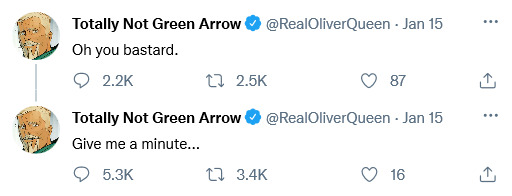

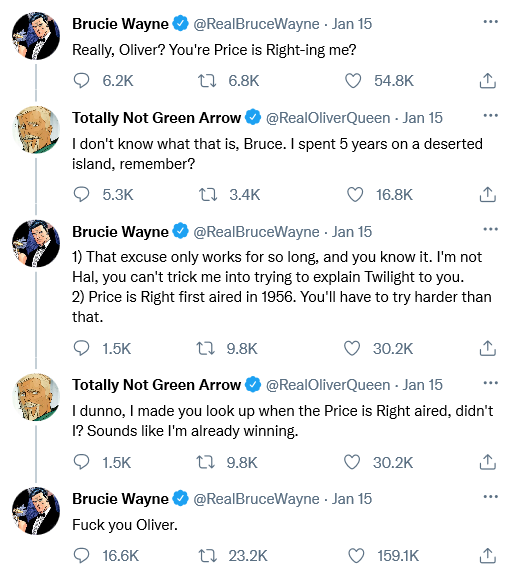

You ever have those moments where an idea just... won't leave your head?
#dcu#batman#bruce wayne#green arrow#oliver queen#fake tweets#things I was not able to adequately convey in the format:#obviously Bruce's reasoning is really a lot closer to Ollie's but Bruce has a secret identity to maintain and Ollie... well#I don't know if you can make it out but his twitter profile pic is him in the Green Arrow costume and that's not accidental#also I am pretty sure that Bruce does just have the first airing date of The Price is Right saved in a corner of his mind palace#just in case it's ever relevant to a case#and he's angry at Ollie because Ollie knows that and also knows Bruce can't admit it because it would raise too many questions#also I did consider an extra scene where they tag-team harass Lex#but it just didn't sound right to me#also I put a whole load of Green Arrow references in here#Q-Core N_Singh and H_Fyff are all from the Nu52 Green Arrow runs#albeit Naomi and Henry are at least in the good Nu52 runs#obviously this is post-Snowbirds Don't Fly/Hard Travelling Heroes in general so Oliver is trolling Hal and setting up needle exchanges#and even Hal explaining to Ollie what Twilight is is a reference to one of the most dated things about the Arrow pilot:#the extremely tacky Twilight joke#anyway hope you enjoyed!
14K notes
·
View notes
Text
hey so we put your boyfriend in a tabletop campaign and now he has a martyr complex. yeah he got protective to the point of being self sacrificial due to his lack of self worth. we gave him a found family so he had something to live for but instead he’s just committed to being a human shield to keep them safe even if it kills him. sorry
#starspeak#ttrpgs#my campaigns#sorry cas.#tumblr boyfriend#edit realized i said human shield. cas is an elf. whoops#i love seeing everyone tag their ocs btw. brings me so much joy#special s/o to everyone in the reforged campaign checking to see if z’ress has been tagged yet#and naomi literally one second after this was posted commenting about ganymede.#btw this is about my own character if that wasn’t. clear.)#get obnoxious (oc tag)
13K notes
·
View notes
Text

bedtime stories (a mathematics textbook)
#temeraire#william laurence#naomi novik#can't believe i forgot to post this temeraire art here when this is where all the temeraire fans are#anyways............ please talk to me about these boys#just finishing up book 8 now..!!!#art requests are so welcome. i want to draw all the characters#once i finish the series i'm going to start it over again immediately i think
1K notes
·
View notes
Text
In the current epidemic of rich Western women who cannot “choose” to eat, we see the continuation of an older, poorer tradition of women’s relation to food. Modern Western female dieting descends from a long history. Women have always had to eat differently from men: less and worse. In Hellenistic Rome, reports classicist Sarah B. Pomeroy, boys were rationed sixteen measures of meal to twelve measures allotted to girls. In medieval France, according to historian John Boswell, women received two thirds of the grain allocated to men. Throughout history, when there is only so much to eat, women get little, or none: A common explanation among anthropologists for female infanticide is that food shortage provokes it. According to UN publications, where hunger goes, women meet it first: In Bangladesh and Botswana, female infants die more frequently than male, and girls are more often malnourished, because they are given smaller portions. In Turkey, India, Pakistan, North Africa, and the Middle East, men get the lion’s share of what food there is, regardless of women’s caloric needs. “It is not the caloric value of work which is represented in the patterns of food consumption” of men in relation to women in North Africa, “nor is it a question of physiological needs…. Rather these patterns tend to guarantee priority rights to the ‘important’ members of society, that is, adult men.” In Morocco, if women are guests, “they will swear they have eaten already” or that they are not hungry. “Small girls soon learn to offer their share to visitors, to refuse meat and deny hunger.” A North African woman described by anthropologist Vanessa Mahler assured her fellow diners that “she preferred bones to meat.” Men, however, Mahler reports, “are supposed to be exempt from facing scarcity which is shared out among women and children.”
“Third World countries provide examples of undernourished female and well-nourished male children, where what food there is goes to the boys of the family,” a UN report testifies. Two thirds of women in Asia, half of all women in Africa, and a sixth of Latin American women are anemic—through lack of food. Fifty percent more Nepali women than men go blind from lack of food. Cross-culturally, men receive hot meals, more protein, and the first helpings of a dish, while women eat the cooling leftovers, often having to use deceit and cunning to get enough to eat. “Moreover, what food they do receive is consistently less nutritious.”
This pattern is not restricted to the Third World: Most Western women alive today can recall versions of it at their mothers’ or grandmothers’ table: British miners’ wives eating the grease-soaked bread left over after their husbands had eaten the meat; Italian and Jewish wives taking the part of the bird no one else would want.
These patterns of behavior are standard in the affluent West today, perpetuated by the culture of female caloric self-deprivation. A generation ago, the justification for this traditional apportioning shifted: Women still went without, ate leftovers, hoarded food, used deceit to get it—but blamed themselves. Our mothers still exiled themselves from the family circle that was eating cake with silver cutlery off Wedgwood china, and we would come upon them in the kitchen, furtively devouring the remains. The traditional pattern was cloaked in modern shame, but otherwise changed little. Weight control became its rationale once natural inferiority went out of fashion.
— Naomi Wolf (1990) The Beauty Myth
#hunger#long post#naomi wolf#the beauty myth#radblr#radfem#radical feminism#radfem safe#radical feminist safe#!!!
732 notes
·
View notes
Text
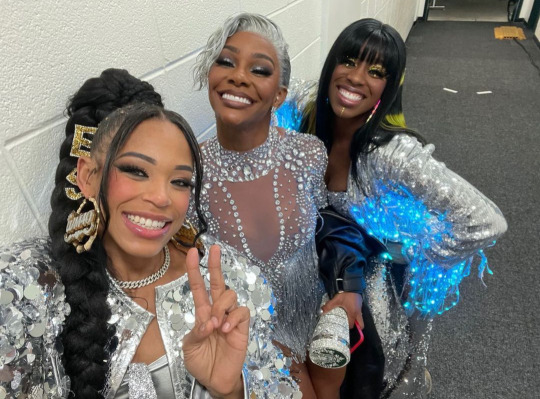

from bianca's story (apr 8 2024)
589 notes
·
View notes
Text


Lien and Temeraire from Naomi Novik's books!
1K notes
·
View notes
Text


❅ cold season ❆
#death note#death note fanart#naomi misora#misora naomi#dn fanart#my art#ahhhhh long time no post#so happy to finally draw naomi#i've started to read labb and I feel like I'm starting to understand her a little better
1K notes
·
View notes
Text
recently i have been seeing people posting videos of traditional uyghur/kazakh/kyrgyz music and dances but then the caption will say “traditional music of chinese province xinjiang” and i just think it’s so dark sided like if you’re going to celebrate the culture of these people you HAVE to say what their ethnicity is, because they are NOT chinese and so much of uyghur culture and language especially is being erased right now.
#Like!!!!!!!!! if you see traditional and xinjiang in the same sentence almost 100% of the time they are talking about uyghur culture#maybe kazakh or kyrgyz or another turkic culture but almost always uyghur culture and we have to acknowledge that!!!!#naomi posts
187 notes
·
View notes
Text








i'll be ringing in your ears
MUNA performing no idea at bonnaroo 2023
#muna#munaedit#katie gavin#naomi mcpherson#josette maskin#musicedit#musicgifs#dailymusicians#dailymusicqueens#wlwsource#mine#IN BROAD DAYLIGHT!!!#theyre so real for this.#kittys gonna be so mad im posting this when shes not online <3 sorry love
802 notes
·
View notes
Text

lobster Naomi from last year ^^
#highlandkall#digital art#cute#furry#tiger#artists on tumblr#her names naomi!#I may have posted this already but im not gonna check lol
581 notes
·
View notes
Text
the thing about el higgins is that terry pratchett would have loved her.
I’ve never encountered a character or a series that I could call a spiritual successor to tiffany aching but el is perhaps the closest possible thing. the way that tiffany’s righteous anger is her magic, born from a sense of deeply rooted love and identity with her home and blossoms into a tempered, powerful ability to see what is in front of her. the way el rages against the systems of oppression she can see and how she follows that rage to the very core and from that core she dismantle those systems. how in both doing the right thing is a choice, always a choice, and one that requires choosing again and again and again. “this far and no further.” “you’re already dead but stay anyway.”
#Tiffany and el both have such strong narrative presence that it’s so easy to forget that they are not reliable narrators#they think they are and that’s how the stories function so incredibly well#because we must go through the journey of also being unreliable and learn along with the characters#no shade but this is a narrative choice that I much prefer to the parable-esque poppy wars or babel#the scholomance#el higgins#tiffany aching#naomi novik#terry pratchett#a post by me
344 notes
·
View notes
Text


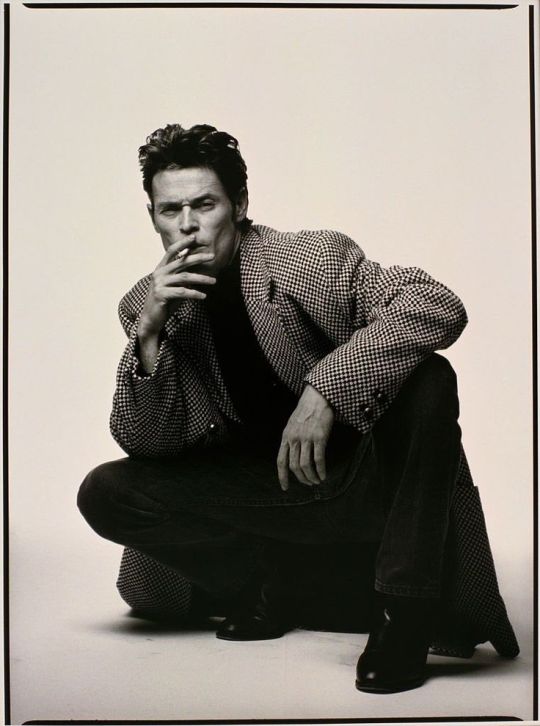



Willem Dafoe, 1999, © Naomi Kaltman
#willem dafoe#naomi kaltman#actors#photography#pics#b/w#1999#90s#soupy's#yall fuckin love this post I have other dafoe posts btw 💀
6K notes
·
View notes
Text

#͏͏ ͏͏ ͏͏ ͏͏ ͏͏ ͏͏ ͏͏ ͏͏ ͏͏ ͏͏ ͏͏ ͏͏ ͏͏ ͏͏ ͏͏ ͏͏ ͏͏ ͏͏ ͏͏ ͏͏ ͏͏ ͏͏ ͏͏ ͏͏ ͏͏ ͏͏ ͏ ͏͏ ͏͏ ͏͏ ͏͏ ͏͏ ͏͏ ͏͏ ͏͏ ͏͏ ͏͏ ͏͏ ͏͏ ͏͏ ͏͏#naomi campbell#90s aesthetic#90s supermodels#90s fashion#90s#fashion backstage#fashion industry#chaotic mannequin#just girly thoughts#girlhood#just girly posts#just girly things#girlblogger#it girl#gaslight gatekeep girlboss#divine feminine#female manipulator#gaslight girlboss gatekeep#hell is a teenage girl#girl blog#manic pixie dream girl#coquette girl#girlblogging#girlblog#girl boss gaslight gatekeep#girl interupted syndrome#just girls being girls#pinterest girl#this is what makes us girls
522 notes
·
View notes
Text


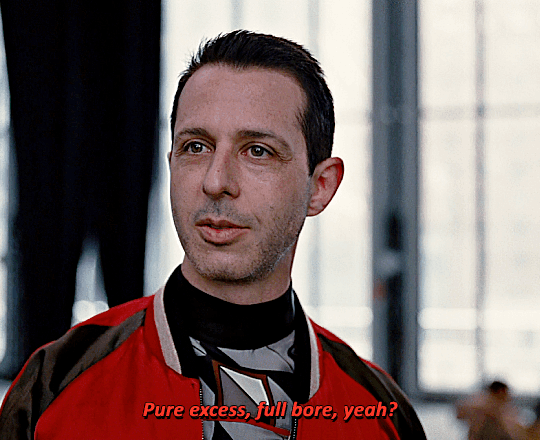
No, it's like I've gone antifragile. I can-- I can accommodate anything.
#successionedit#i know i should have posted this on friday whatever happy keneaster to all who celebrate#succession#kendall roy#naomi pierce#beegifs
164 notes
·
View notes